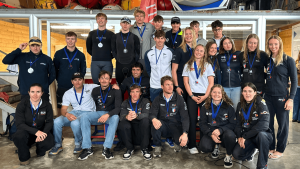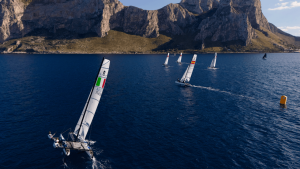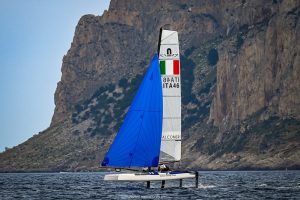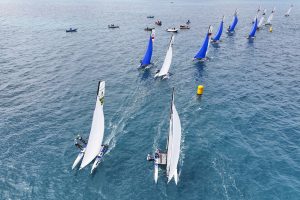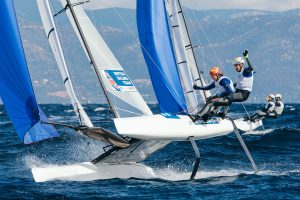More feedback on the Nacra 17 Full Foiling Tests.
We caught up with Chris ‘foiling’ Rashley after a 3-day stint testing the new foiling set Nacra 17’s. Sailing with British Olympic crew Nicola Groves, the duo was nicely welcomed to what is a well set up testing program. The two foilers, one converted, one new build both went out all three days.
The first day was light, in the 5-10 knot range. Boats are being tested in the configuration of both daggerboards down all the time in anticipation of class rules requiring it. With so much foil underwater, both Chris and Nic said they could feel the drag set up as higher than the C foil set up, sailed with the windward board raised. The boat still tracked and sailed nicely enough but the extra underwater surface area was noticeable.
Turning around the windward mark, Chris was surprised at the early take off for the boat. At the 6-7 knot range, a pretty low wind-speed threshold, the boats foiled downwind steadily, and could even coast through stretches of lighter wind if up already. “Overall, it’s going to be noticeably quicker around the track in light winds,” said Chris. It’ll be a bit slower upwind, but the downwind was much faster with such an early take off.
Days 2 and 3 of the Brits testing was in more like the 15-20 knot wind range, so full on sailing. Chris talked a lot about the modes upwind noting that in the new video released its them in most of the drone footage. With the Z foil configuration, the vertical section of the leeward foil is relatively short. The short vertical results in a narrow range where the boat has solid tracking upwind. If a team loses their mode they will be punished, either through dropping the leeward hull in the water and losing speed or raising up too high and risking leeway.
It’s been a common theme from the sailors we’ve talked to about how tough this boat is going to be to sail well upwind.
Crew work rates have initially gone up, as mainsheet trim has been used extensively by the testers to keep the boats in the right ride height and mode upwind. No doubt, as teams getting better at weight placement, steering, traveler, mainsail set up, and other tricks upwind work will be fine-tuned to make it easier to sail, but even with all the tricks it seems like it’s going to be a real test to sail well upwind. When chop or waves are added, the physical test will increase even more so. What we should expect is that first beats and especially fighting off the start line could be more about who gets their sailing correct in the moment versus the finer details of overall set up that often end up dominating Olympic sailing.
Chris was pessimistic about the chances of the boat foil tacking, stating that the AC boats have much lower drag profiles in the air. Already, the outside hull is foiling all the way around the tack, so tacks are already faster than the c foil set up, but the new leeward hull is always dropping into the water and Chris thinks that will be the way it is.
Chris was very complimentary of the converted boat platform, stating he didn’t observe a performance difference between the retrofit and the new boat. This is in contrast with Bora Gulari’s observations, who was very complimentary of the stiffness of the new boats, but in fairness Bora’s comments were more about feel while Chris’s were more about performance. It’s certainly would relieve some class pressure if the converted boats end up being useful and fair with regard to performance versus the new builds.
There has also been a lot of work done by class members to check and double check the new construction methodology, systems, and structures as outlined. Luckily, many class members have access to some of the top talent in the global cat scene. One sailor is working within an AC teams has his AC teams designers, builders, and engineers review at high level all aspects of the construction and build proposals. They confirm the new build plan reflects best practice in all areas for modern performance catamarans. Carbon skin, infusion, added bulkheads and the daggerboard case design are all in line with the best in line with current AC thinking.
Testing will continue as long as weather allows, and there are some weeks open for class members who wish to brave the cost and see what it’s all about in person.

